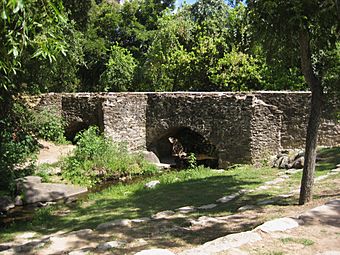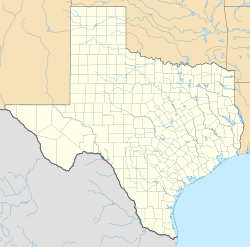Espada Acequia facts for kids
|
Espada Aqueduct
|
|
|
U.S. Historic district
Contributing property |
|

The Espada aqueduct as it crosses Piedras Creek.
|
|
| Location | Espada Rd., E of U.S. 281S |
|---|---|
| Nearest city | San Antonio, Texas |
| Built | 1731 |
| Part of | San Antonio Missions National Historical Park (ID78003147) |
| NRHP reference No. | 66000809 |
Quick facts for kids Significant dates |
|
| Added to NRHP | October 15, 1966 |
| Designated NHL | July 19, 1964 |
| Designated CP | October 6, 1975 |
The Espada Aqueduct, also called the Piedras Creek Aqueduct, is a very old water bridge. It was built in 1731 by Franciscan friars. You can find it in what is now San Antonio, Texas, in the United States.
This aqueduct was made to bring water for irrigation to the farms. These farms were close to Mission San Francisco de la Espada. Today, this mission is part of the San Antonio Missions National Historical Park. The aqueduct is still used today! It is also recognized as a Historic Civil Engineering Landmark and a National Historic Landmark.
Contents
What is an Acequia?
An acequia (say: ah-SEH-key-ah) is a special kind of water channel. It is like a small canal or ditch. The acequia system at Mission Espada is still working today. Its main ditch, called the acequia madre, still carries water. This water goes to the mission and its old farmland. People living on these lands still use this water.
Why Were Acequias Important?
For a new mission to survive, growing crops was super important. In south central Texas, it does not always rain a lot. So, having a steady water source was a big deal. Building an acequia system was a top priority for the friars.
The Spanish colonial settlers cared so much about irrigation. They even measured farmland in suertes. A suerte was the amount of land that could be watered in one day.
Where Did Acequias Come From?
The idea of using acequias came from the dry parts of Spain. The Romans and the Moors first brought this system there. When Franciscan missionaries arrived in the desert Southwest, they saw it worked well. The hot, dry weather was perfect for it.
In some places, like New Mexico, this system fit right in. The Puebloan Native Americans already had their own irrigation systems.
How the Espada System Works
The Franciscan missionaries built a big water network. They made seven gravity-flow ditches, dams, and at least one aqueduct. This network was about 15 miles (24 km) long. It watered around 3,500 acres (14 km²) of land. The acequia did more than just bring drinking water and irrigation. It also powered a mill!



